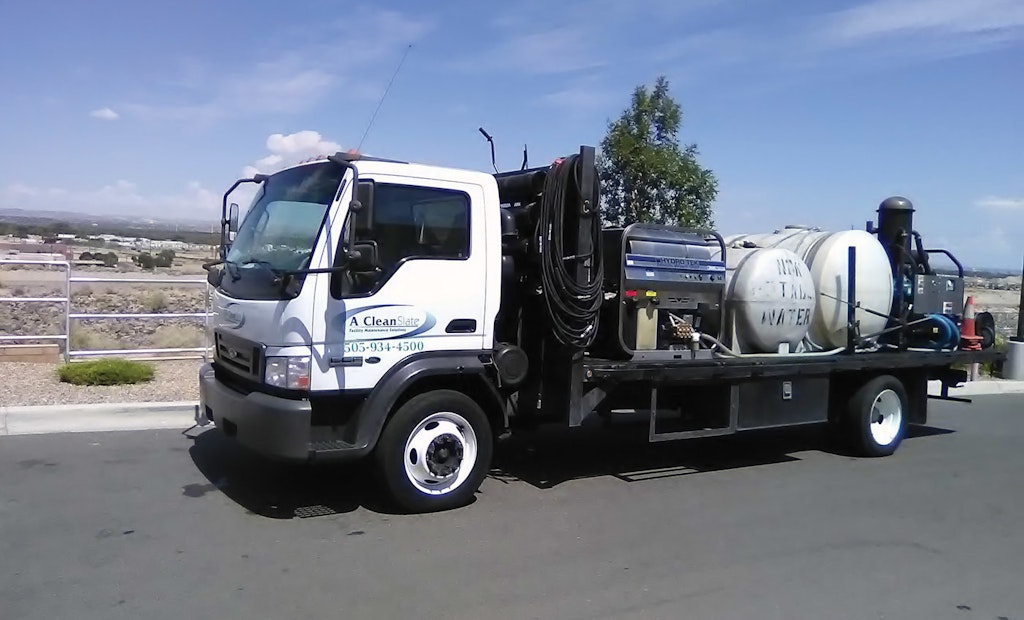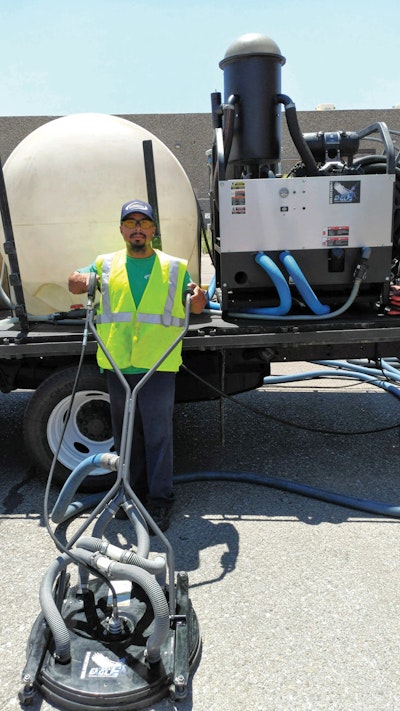
The 24-inch-diameter Steel Eagle Clean and Capture systems aid A CleanSlate crews in recovering dirty water so it doesn’t run off into stormwater drains during cleaning jobs.
Interested in Cleaning?
Get Cleaning articles, news and videos right in your inbox! Sign up now.
Cleaning + Get AlertsAt A CleanSlate in Albuquerque, New Mexico, crews typically clean anywhere from 800,000 to 1 million square feet of concrete surfaces a month, which provides a compelling case for investing in reliable equipment that makes short work of tough jobs.
That’s where Steel Eagle Clean and Capture Systems step in and enhance productivity, as well as recover used water, giving owner Steve Slater an eco-friendly marketing angle to win over water conservation-minded customers.
The company cleans a wide variety of flat surfaces — think gas-station pavement covered with gas, oil, coffee, and soda spills; strip mall sidewalks and parking lots; dumpster pads; and factory floors covered with grease and grime. Other markets include pressure-cleaning vehicle fleets, as well as hood vents in restaurants and other cooking facilities.
“When we’re cleaning that kind of surface volume a month, we want to work as fast and efficiently as we can,” says Slater, who established the company in 2003 and serves customers in about a 60-mile radius around Albuquerque. A CleanSlate employs 15 to 20 people and runs three trucks: two GMC 5500 box trucks with 16-foot bodies and a Ford LCF cab-forward 20-foot flatbed truck.
“Whether we’re doing flat-surface cleaning or washing some 3,800 vehicles a month … the Steel Eagle systems make our crews faster and more efficient,” he says.
To clean flat surfaces, the company’s crews typically use a 24-inch-diameter Steel Eagle Clean and Capture unit that’s powered by a hot-water power washer and connected to a Steel Eagle Fury 2400SE vacuum unit. The company relies on six SC3500 hot-water power washers made by Hydro Tek - Cleaning Equipment Mfg. (3,500 psi at 5.5 gpm).
The Steel Eagle systems ensure that crews can wash, rinse and instantly recover dirty water so it doesn’t run off into stormwater systems. This helps the company bid on jobs that require water recovery. The system recovers 98 percent of the water used, according to the Steel Eagle website. The water usually is pumped into a 300-gallon holding tank (located in a service truck), then put into sanitary sewer lines for municipal treatment, Slater says.
The Clean and Capture tool looks similar to a very thin lawn mower. It comes in three cleaning-path diameters — 24, 16 or 11 inches. The deck is made of stainless steel with a powder-coated finish. Water flow is controlled by a trigger on one of the unit’s two handles.
Through two jets on the underside, the units deliver maximum pressure of 4,000 psi with flow ranging from 5.5 to 8 gpm, depending on the cleaning-path diameter. The largest machine weighs 52 pounds; the smaller units weigh 35 and 14 pounds, respectively.
The Fury vacuum unit is compact, but powerful and features a belt-driven, positive displacement Tuthill blower (475 cfm), equipped with a MagnaFlow silencer, and a 50-foot vacuum hose. The heavy-duty frame measures 25 by 36 by 29 inches.
Slater first heard about the Steel Eagle system a couple years after he started his business. He concedes he was a bit skeptical, but was quickly won over by the performance of the first unit he bought. The company now owns six cleaning units and three Fury vacuum units, with two more complete systems on order, he says.
“We love the fact that the recovered water goes through a 55-gallon primary separation tank, where solids fall to the bottom,” he explains. “Then the water gets skimmed off into another filter-bag system, then immediately pumped into a 300-gallon holding tank. So the water gets skimmed and filtered twice.”
Much of the company’s work is contractual in nature, typically requiring weekly, biweekly, monthly or quarterly cleaning. To sell customers on the company, its employees, and equipment, Slater takes the somewhat unusual step of inviting them to the company’s headquarters for an equipment demo and to meet employees and tour the facilities. “They get a sense for our reliability through the equipment we use,” he notes.
Moreover, when customers see the entire scope of the company’s operation, including the investments in equipment, they better understand its rate structure. “We’re not the cheapest and we don’t want to be,” Slater says, noting that all three machines in the system — the power washer, cleaning unit and vacuum unit — operate on either diesel fuel or gasoline, which adds cost to projects. “But by the time we’re finished showing people around, most clients understand our process. They see why it costs more money to operate our business this way.”
Reliable equipment is critical to the company’s profitability. Slater often runs crews on three shifts a day, seven days a week. “A Fury might run for 12 hours a day,” he says. “Our equipment has to be operational for the next crew, so reliability is key.” Employees perform oil changes on a weekly basis, which helps keep the units up and running smoothly. And when issues arise, Steel Eagle machines are simple to work on, Slater adds.
“I need professional-grade equipment where you turn the key and it fires up and runs efficiently, as designed,” he concludes. “Our Steel Eagle equipment allows us to service clients more quickly and get more jobs done per week.”






